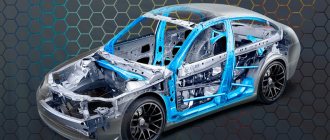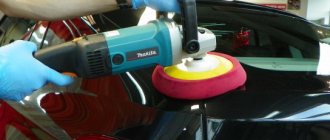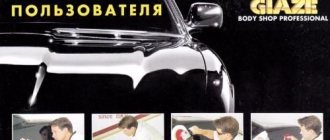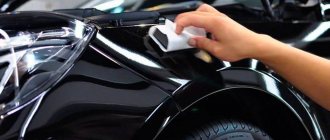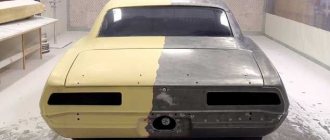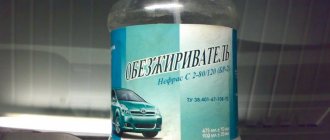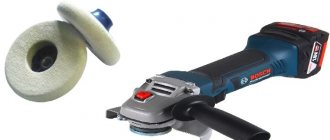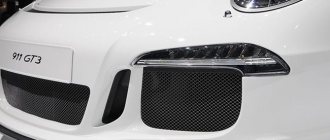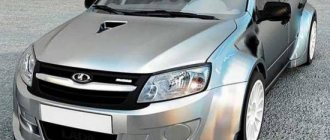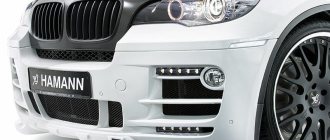It is important for a car owner to monitor not only the technical condition of the car, but also its appearance. To put the car body in order, you need to not only wash it with shampoo and wax, but also pre-polish it. Owners resort to polishing the car body not only to give the car a presentable appearance, but also to protect the paint layer from destruction. Polishing is also done to remove small scratches on the paintwork. The type of nozzle for polishing a car determines how to obtain a high-quality result, so let’s look at their types and features of use.
Why do you need to polish a car body?
Polishing is the process of rubbing a car body with special lubricants that protect the paintwork and remove minor scratches. In order for the car not only to be clean, but also to shimmer in the sun, it is necessary to regularly carry out polishing operations. These operations allow you to solve a number of the following problems:
- Avoid premature destruction of the paint layer
- Protect the body from corrosion
- Make the paintwork shiny, which allows you to effectively highlight your car
- Remove minor scratches and abrasions of the paint layer
To carry out polishing operations, you will need the following set of tools and consumables:
- Power tool - this can be an angle grinder or grinder, drill, screwdriver, eccentric or polishing machine. When using an angle grinder to polish a car body, you need the tool to have a speed control option
- Car polishing nozzles are special devices made of soft materials, through which polishing paste is rubbed into the paint layer of the body. Exactly what types of nozzles for car polishing there are, how they differ, and for what purposes they are intended, is described in detail in the material
- Adapter, mandrel or plate - a device onto which the polishing attachment is attached. Such adapters have appropriate fasteners for installation in the chuck of a drill, screwdriver or on the spindle of an angle grinder and polishing machine. The adapter is used for removable drives, but there are also non-removable devices. They are less popular because they are more expensive. Fixed nozzles are equipped with fastening elements and therefore do not require the use of adapters. It is important to note that the plates are available in diameters of 115, 125 and 150 mm. In addition, they can have a hard and soft base on which a polishing disc is attached. The soft layer on the plate eliminates the beating effect (the vibrations of the power tool are smoothed out), which is especially important when working with sheepskin attachments
- Polishing paste is a consumable material that protects the paintwork of the body, removes scratches, and also achieves shine.
This is interesting!
Car polishing is performed not only to remove minor scratches, but also to protect the paintwork from the negative effects of water, sun and other influences. The recommended frequency of work on rubbing the body paint is once every 3-4 months.
Wheels for car polishing
What you need to know about polishing pads
Wool disc
Abrasive disc
Felt disc
Vulcanite disc
Felt disc
Disc ZM
Recommendations
There comes a time in the life of every car enthusiast when small scratches appear on the surface of the car, to remove which we need a polishing wheel. Car polishing may be necessary not only because of accidents. Scuffs, chips and scratches will certainly appear on the car of a very careful driver. Defects in the paint layer are caused by mechanical damage from collisions with small stones that fall on the body while driving, snow removal in winter, car washing and many other reasons. To renew the coating and make it smooth and shiny again, they resort to a service such as polishing the iron horse.
Farecla polishing wheel G MOP 6
What you need to know about polishing pads
Car polishing is the most common and popular procedure. With its help, you can not only significantly improve the appearance of the car, but also extend the service life of some parts. Not only the metal parts of the machine are polished, but also the glass and plastic. They polish the car body, glass and even headlights.
It is quite possible to polish your car yourself. This is a completely simple process that even beginners can handle. In order to perform this manipulation, not much is required. You will need to purchase a special polishing machine, and if you don’t want to spend extra money, then a regular electric drill can easily replace it.
In order to polish your car with high quality, you will need to buy special discs that are attached to a machine or drill. There are two types of fastening the disc to the polishing machine - using Velcro and using threads. If everything is clear with the thread (you just need to screw the disk to the machine), then some craftsmen are skeptical about attaching the disk using Velcro. Many people are afraid that during the polishing process the disc will come off, and this will lead to damage to the polished surface. However, these fears are unfounded. Both types of fastenings are quite reliable.
Polishing wheels from 3M
Most manufacturers mark car polishing wheels with a special color:
- white – with increased rigidity;
- orange – universal disk;
- black is the softest.
Depending on how damaged the finish is or what effect you are trying to achieve, you should choose a polishing pad. Polishing wheels can remove both small scratches and significant chips from the surface of a car.
To remove small scratches or add shine to your car, it is recommended to use fur pads. For hard-to-reach places, there are discs with twisted wool thread. The choice of polishing wheel is also influenced by the abrasiveness of the paste used. All these points are important to consider to achieve maximum results.
Since a car polishing wheel is a consumable item, you need to carefully monitor the degree of wear and replace it in a timely manner.
Wool disc
The wool disc is the most popular among car enthusiasts. It is used most often due to its effectiveness, and it is very inexpensive. Wool discs are used for rough processing of paintwork.
Sheep wool polishing disc 150 mm
Products made from twisted wool thread are used to eliminate medium-depth scratches. Experts use wool wheels for rough work when processing car surfaces.
Abrasive disc
Abrasive discs are also used quite often. They are tough, just like wool ones. However, they are more effective and, accordingly, their price is higher. The abrasive layer of such a wheel consists of chromium, silicon and electrocorundum. This type of polishing wheel is used in the initial stages.
Felt disc
The felt disc for polishing can be thick wool, medium wool and fine wool. The most commonly used thick wool felt circle. Used to remove deep scratches. Medium wool discs are used for minor chips and scratches. Fine-haired - practically not used as a wheel for polishing a car.
Types of polishing work
First, let's understand that car polishing is classified into two main types of work:
- Protective - such operations allow you to ensure reliable protection of the paint layer from minor mechanical stress, abrasions, and even to avoid the varnish losing its characteristics. Pastes used for rubbing car bodies include substances such as Teflon, wax, etc.
- Restoration is the most common type of work in which car owners resort to polishing the body of their car. They resort to restoration work to remove minor scratches and other types of deformation of the body paint, for example, paint fading in the sun. The principle of restoration work is to remove the top oxide layer. For this purpose, special types of polishing pastes are used. After carrying out restoration work on polishing the body, it is imperative to rub the body with protective paste
You need to decide on the type of polishing work in order to choose the right attachments. After all, the quality of work depends not only on the substance used, rubbed into the body, but also on the material from which the nozzle is made.
How to make it yourself
It’s worth figuring out how to make a polishing disc for headlights with your own hands. The basis of the disk is linoleum. Its reverse side adheres well to the drill attachment. Foamed polyurethane is used as a substrate. The polishing layer is represented by sandpaper. First, 2 layers of polyurethane are glued onto a piece of linoleum, and then sandpaper.
As you can see, there are many types of polishing discs for grinders, which motorists use to process bodywork, glass, and wooden elements. During the polishing process it is often necessary to change the grain size of products. You can easily create a simple circle with your own hands from linoleum, polyurethane and sandpaper.
What types of nozzles for polishing a car body are there?
Depending on the type of polishing work, it is necessary to use appropriate attachments. When using protective pastes, delicate nozzles are used, and if it is necessary to remove scratches and abrasions of the paintwork, you will need to use abrasive devices. The polishing procedure can be carried out using drills, screwdrivers and grinders. To do this, it is not at all necessary to buy special polishing machines. Only when using the power tools in question, one detail needs to be taken into account - they must have a speed control function.
This is interesting!
Most standard grinders do not have the option of adjusting the rotation speed, so they are not suitable for polishing cars.
To be able to work with an angle grinder, you should purchase a special voltage regulator - a dimmer. Now let's look at the types of polishing attachments for cars. They are made from different materials, but the most popular are foam and sheepskin attachments.
Let's sum it up
The use of high-quality materials makes it quite easy to carry out polishing work on your vehicle. You can do everything yourself and not pay quite impressive sums for the services of specialists. Polishing products are sold in any automotive store, but you should be careful where you purchase and select products. Not all polishing pads will be suitable for your task. Quite often, products turn out to be of poor quality if their price is too low.
Well-known global manufacturers offer a fairly large number of interesting solutions for processing vehicle bodies. But often you have to buy a whole range of materials for your case. In this situation, it will be quite easy to get the job done at a high production cost. Moreover, retail prices in stores are significant. You can find analogues to branded solutions with decent quality. Remember that do-it-yourself polishing is carried out only if the important conditions and instructions for this process are observed.
Felt or felt polishing supplies for car
Felt or felt - felt tips are extremely rare. They are intended for cleaning the body surface before polishing, as well as at the final stage of using polish. Felt nozzles are characterized by increased softness, and they are available in cylindrical and flat shapes. They are not suitable for cases where it is necessary to remove minor defects on the car body. They are used with a drill, screwdriver and grinder that has a speed control function. Their disadvantage is that due to the dense base, the car body heats up.
Sheepskin nozzle for car polishing and its types
Sheepskin attachments for drills and screwdrivers are used to apply a protective layer of polishing paste, as well as remove scratches and other defects. For this purpose, sheepskin equipment is available in different types - regular or classic pile, natural sheepskin, and also twisted pile.
Many people mistakenly believe that sheepskin is intended for finishing or for applying a protective layer. However, this is not at all true. They are intended for starting treatment and removing scratches. After their use, small marks remain, so they are not suitable for finishing. That is why, after using sheepskin equipment, it is necessary to use foam rubber attachments. The length of the pile of sheepskin nozzles ranges from 25 to 40 mm, and the larger their size, the better the cooling.
- Classic sheepskin.
The use of classic sheepskin devices makes it possible to achieve a special shine of the paintwork, which is why they are often used at the final stage for almost all car models, from domestic to foreign cars. - Twisted pile.
With twisted pile, sheepskin is intended for rough or aggressive polishing, that is, when it is necessary to remove small scratches and other paint defects - Natural sheepskin for delicate processing.
The equipment is made of natural sheepskin, which is yellow in color, provides the most gentle effect, and is used for finishing. Typically, devices made from natural sheepskin are used to process German-made cars - BMW and Mercedes-Benz. They differ from the first two options in their high cost, which is due to their production from the wool of rare animals
All types of sheepskin polishing equipment are designed to operate at speeds from 400 to 1500 rpm. This speed mode ensures their maximum efficiency and productivity.
Foam polishing attachments types and purposes
Foam nozzles are used not only for applying protective, but also restorative polish at the finishing stage. Manufacturers produce foam nozzles in a wide variety. The foam base differs in the size of the cells, and the smaller they are, the correspondingly softer the effect. To remove small scratches from the car body, you need to use foam rubber attachments on a drill and a screwdriver with large cells of increased rigidity. Different colors of foam nozzles allow you to accurately apply the appropriate pastes.
Foam nozzles are available in two types - petal (with a grooved base) and flat. They differ not only in appearance, but also in the quality of surface treatment. Flat ones carry out the same type of surface treatment, while petal ones, due to their protrusions, allow for delicate processing due to the small area of their contact. Corrugated ones are used for applying wax, as well as removing holograms - small marks on the paintwork. The advantage of corrugated tools over flat ones is that they do not heat up the surface being treated too much.
In addition to the material from which the nozzle is made, it is important to pay attention to the degree of its rigidity. The effectiveness of removing scratches and giving car paint a special shine depends on its hardness. Based on the type of hardness, polishing pads are classified into hard, medium and soft.
- Hard - used to remove scratches, chips, plaque and rust from the car body
- Medium hardness - used to rub the surface of the body and give it a glossy shine. Allows you to smooth out minor paint defects in the form of abrasions
- Soft - through which the final cleaning of the body surface is carried out
The effectiveness of hologram removal also depends on the structure of the equipment. They are dense and soft. The denser the disc, the more aggressive processing it is designed for. If we compare foam rubber and sheepskin discs, the latter are designed to remove larger marks than the former.
This is interesting!
Polishing a car body is carried out mainly using several types of attachments. It is impossible to carry out work with one nozzle and still achieve the desired result.
Wool polishing wheels
The wool wheel is very effective for abrasive polishing. It removes scratches faster and effectively removes oxidation marks on paint. The wool wheel is capable of removing even traces of 1200 abrasive. They are used only on rotary polishing machines.
The total time of exposure to the surface is less than when polishing with foam wheels. Consequently, the paintwork heats up less, but not only because of this. Wool circles dissipate heat through the fibers.
The main disadvantages of these wheels are that they leave circular polishing marks (“holograms”), clouding, and require more abrasive paste. But not all wool wheels are designed for harsh abrasive action.
Fabric polishing pads
Cloth attachments are used primarily for manually rubbing polishing paste into the paintwork. An example of hand-held attachments made of fabric is shown in the photo below.
This is interesting!
You can perform initial and final polishing of the car body with foam rubber discs, but it is impossible to perform these procedures with sheepskin attachments. After processing the sheepskin equipment, you need to use soft foam discs.
Main types
Abrasive
Such discs are suitable for rough processing of stainless steel and various types of metals, stone and concrete, wood and plastic. Used before final polishing.
Composition of microcrystals in abrasive wheels:
Self-hinging
Suitable for both manual grinding and machine or grinding machines. Used for polishing furniture, metal structures and cars. Attached with Velcro to the support plate.
Abrasive polishing wheel for cars
Volcanic
Their base is vulcanized rubber with additives and microcrystals. It is used for grinding metal surfaces, as it has a high heat capacity.
Felt
These are car polishing discs made of thin fabric that eliminate scratches, cracks and chips. Any surface can be treated. Before polishing, the fabric is wetted with an emulsifying substance called polish.
Foam rubber
These discs are made of polyurethane foam.
They have different colors and composition:
Foam rubber discs come in different shapes:
Vulcanite wheels for car polishing
Felt
These circles are made of dense pressed wool. Suitable for grinding with a grinder or on a machine. Eliminate defects from metal and stone surfaces. Discs made from this material should be stored in a clean and dry place. Pumice is used to clean dirt from the felt circle.
What are the pros and cons of car polishing attachments?
Knowing what types of polishing equipment for car bodies are produced, it will be important to consider their advantages and disadvantages. First, let's look at the advantages and disadvantages of foam discs.
- Foam rubber wheels for cars have disadvantages such as heating the surface being treated and high paste consumption
- The advantages of such devices include a wide variety of choices and affordable prices.
For comparison, let's look at the pros and cons of sheepskin attachments for polishing a car:
- Pros: effective in removing scratches (even the largest ones), they do not consume a lot of paste, which means they have low consumption. In addition, such discs do not heat the surface, which is very important when polishing by beginners.
- Disadvantages - they do not allow for finishing, as they leave small scratches and holograms. In addition, their price is higher than foam rubber, and there is little choice
Based on the advantages and disadvantages of both types of polishing attachments, we can draw a conclusion about which types should be chosen in specific cases.
Rotary or random orbital polisher?
Eccentric machines do not create circular marks when operating at any speed. Orbital polishers are usually made to be more powerful than rotary polishers and allow you to polish at higher speeds. With all this, it is more difficult to remove scratches with this machine; you have to set high speeds, which creates vibration. It takes longer to achieve results than with a rotary machine. The wool wheel is not used on eccentric machines.
When used correctly, a good and most effective combination is a rotary polisher and a wool pad.
For example, when using a double-action eccentric polisher, only foam wheels are always used.
How to choose a car polishing attachment
You can perform high-quality polishing of a car body not only in a specialized car service center, but also at home. The quality of the work largely depends on various factors, but one of them is the choice of the appropriate nozzle. When choosing polishing attachments for a drill, screwdriver or grinder, you need to consider the following factors:
- Manufacturer and price - if you set out to produce high-quality polishing of the car body, then you need to approach this issue with the utmost rigor and seriousness. Buying cheap little-known attachments or without a manufacturer’s name at all is dangerous because you will not only not be able to get the desired result, but will also ruin the paintwork. That is why it is better not to save money and choose equipment from well-known manufacturers such as 3M, Mirka and others
- Purpose - it all depends on what goals you are pursuing. For protective polishing, soft nozzles are used, and to remove scratches and other defects, abrasive nozzles with a high degree of hardness are used. To polish car headlights, completely different types of attachments are used, so you should not combine them and make them universal
- Speed of work - this factor also needs to be taken into account, since failure to use the equipment at speed will lead to the fact that you can “burn out” the paintwork of the body. On the nozzles, manufacturers indicate the recommended speeds for their use, which also determines the choice of a suitable power tool for the job.
- Size or diameter. Round nozzles are produced with a diameter of 115 to 150 mm. It is important to take this value into account if you plan to carry out work using an angle grinder or a grinder. If a drill or screwdriver is used for polishing, then it does not matter much what size the adapter and working equipment are. The larger the diameter of the equipment, the higher the processing speed, however, it is not recommended for a beginner to buy a device larger than 125 mm, since the processing procedure becomes more complicated due to high vibrations and the need to control the surface being processed
- Type of nozzle - they are removable and non-removable. They differ only in price. Beginners are recommended to use removable attachments, as they allow polishing with quick replacement of attachments.
There is no clear answer to which nozzles are best to use for polishing a car body. To achieve the result, you will need to buy a set of appropriate equipment. However, purchasing such a set is not a guarantee that the work will be done with high quality. Pay attention to what types of polishing pastes for cars there are, and how to choose them (link). To polish hard-to-reach places, for example, cast car wheels, specially shaped equipment is used - cylindrical, conical and others.
To summarize, it should be noted that before polishing a car body for the first time, you must first practice on other surfaces. The wrong choice of nozzle for roughness, as well as rotation speed, will lead to immediate damage to the paintwork. That is why it is very important to be responsible when choosing power tools, polishes and attachments for polishing a car.
What material to choose a disc from?
Today, the market offers a wide range of car polishing attachments that help remove both small cracks and deep chips. Let's take a closer look at them.
Wool wheels
Wool discs are the most popular due to their low cost and efficiency. Such products are suitable for rough processing of paintwork.
A harder finish can be achieved using a polishing wheel made from twisted wool thread. Such products are suitable for medium-depth cracks and small defects.
Abrasive discs
Wheels made from abrasive materials are also considered hard, but unlike their woolen “colleagues”, they are more efficient and, accordingly, more expensive.
The products have these properties due to the special chemical composition of the polishing surface coating itself. More often, the abrasive layer is made of electrocorundum, chromium and silicon.
Felt discs
Circles made of felt are most often used for metal car body parts. Such products come in different types, depending on the level of wooliness of the polishing coating. For polishing, it is recommended to purchase thick-wool wheels, which work best at removing fairly deep scratches from non-ferrous metal surfaces. Fine wool circles are used the least often.
The diameter of felt discs can be from 70 to 250 mm, and the width remains the same - 25 mm.
Vulcanite (rubber) wheels
Such discs remove a thin layer of paintwork, after which the surface has a mirror shine. Therefore, vulcanite wheels are used only at the final stage of polishing, when coarser disks have already been used.
The polishing surface of the wheels is made of vulcanized rubber with the addition of abrasive components.
As a rule, only metal surfaces are treated with a rubber polishing disc at the final stage of restoration work.
Felt discs
Felt wheels are used at the stage of basic work, after rough processing, but before final polishing.
Felt products cope with most types of damage and work effectively not only on metal surfaces, but are also suitable for headlights, glass, bumpers and other body parts.
When using such a universal product, one important nuance must be taken into account - the disc must be periodically moistened in water. Then it will be several times more effective.
Also, felt discs are suitable for almost all polishing pastes, together with which they remove scratches even faster.
ZM disks
This type of wheel is used after the car parts have been coated with primer and varnish. Such products are the easiest to attach, and sometimes even used without grinding machines. By and large, ZM is a cheap consumable material for washing and dry polishing body parts made of any material.
Foam rubber is most often used as a polishing layer in such discs. When choosing foam discs, it is worth considering one nuance - the smaller the cells of the circle, the better it will polish the paintwork.
Please note that the attachment on a drill for polishing a car will be less effective compared to a disk mounted on a grinder (or as it is popularly called, an angle grinder). Therefore, let's look at some recommendations for choosing specialized equipment.
